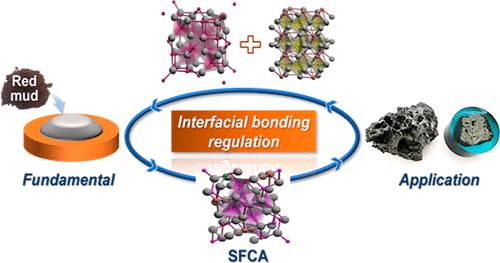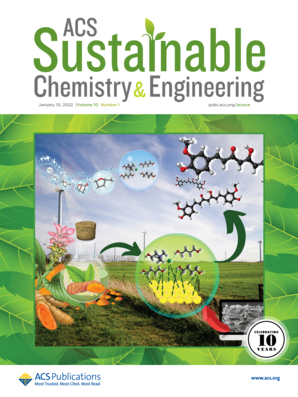Integrated Recycling of Red Mud for Iron Ore Sinter Manufacturing: Interfacial Bonding Regulation of the Sintering Process
IF 7.1
1区 化学
Q1 CHEMISTRY, MULTIDISCIPLINARY
引用次数: 0
Abstract
Recycling of red mud (RM) has posed an enduring challenge for the alumina industry. This work offers a comprehensive investigation into the fundamental and applied research of RM blend into the iron ore sintering process. Microsintering test was employed to investigate the formation and properties of bonding phase affected by RM. It resulted in impairment of bonding phase infiltration onto the iron ore surface and a decrease in the interfacial bonding strength. The interfacial interaction mechanism showed that the excessive TiO2 and Al2O3 brought by RM leads to the transformation of calcium ferrite (the target bonding phase) into perovskite and spinel with high melting points, resulting in the evolution of bonding phase from original dense strip-crystallized structure to fine-grained porous. Incorporation of CaO in conjunction with RM facilitates the formation of calcium ferrite within the bonding phase and enhances its infiltration on the iron ore surface, thereby augmenting interfacial bonding strength. Pilot-scale sintering was successfully conducted with 6% RM and 1.5% quicklime. The sinter yield of 76.68% and a tumbling index of 64.98% can be obtained, which were comparable to those achieved without RM, offering a feasible approach for large-scale recycling of RM in the steel industry.

铁矿烧结生产中的赤泥综合回收利用:烧结过程中的界面结合调节
赤泥(RM)的回收利用一直是氧化铝行业面临的挑战。本研究对铁矿石烧结过程中赤泥混合的基础和应用研究进行了全面调查。采用微烧结试验来研究受 RM 影响的结合相的形成和特性。结果表明,RM 对铁矿石表面的粘结相渗透产生了影响,降低了界面粘结强度。界面相互作用机理表明,RM 带来的过量 TiO2 和 Al2O3 导致钙铁矿(目标结合相)转变为高熔点的包晶和尖晶石,使结合相从原来的致密条晶结构演变为细粒多孔结构。氧化钙与 RM 的结合促进了结合相中钙铁素体的形成,并增强了其在铁矿石表面的渗透,从而提高了界面结合强度。使用 6% RM 和 1.5% 生石灰成功进行了中试烧结。烧结矿产率为 76.68%,翻滚指数为 64.98%,与不使用 RM 的烧结矿产率相当,为钢铁行业大规模回收 RM 提供了可行的方法。
本文章由计算机程序翻译,如有差异,请以英文原文为准。
求助全文
约1分钟内获得全文
求助全文
来源期刊

ACS Sustainable Chemistry & Engineering
CHEMISTRY, MULTIDISCIPLINARY-ENGINEERING, CHEMICAL
CiteScore
13.80
自引率
4.80%
发文量
1470
审稿时长
1.7 months
期刊介绍:
ACS Sustainable Chemistry & Engineering is a prestigious weekly peer-reviewed scientific journal published by the American Chemical Society. Dedicated to advancing the principles of green chemistry and green engineering, it covers a wide array of research topics including green chemistry, green engineering, biomass, alternative energy, and life cycle assessment.
The journal welcomes submissions in various formats, including Letters, Articles, Features, and Perspectives (Reviews), that address the challenges of sustainability in the chemical enterprise and contribute to the advancement of sustainable practices. Join us in shaping the future of sustainable chemistry and engineering.
 求助内容:
求助内容: 应助结果提醒方式:
应助结果提醒方式:


